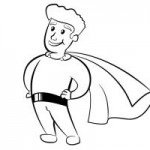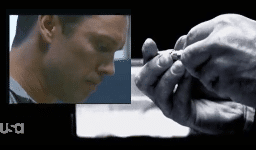We’ve talked about how to get into a character’s head here before, and it seems most of us discover our characters along the way, but the perennial question came up recently on one of my writers’ email loops. I especially liked the breadth of the following answer by member John Waverly, reprinted here with his permission (with video and formatting, including emphasis, added).
Call me weird, but I collect things like this. Here’s some of the ideas I’ve collected:
Write a day in their life
This is kinda like [a previously posted] journal idea, but it doesn’t have to be first person. I like starting by describing their name on a nametag. Then zoom out and describe their clothes and their physical characteristics. Then zoom out and describe where they are and why. Who else is there? What do they think about these people? Etc. At some point they leave and go home. Why do they leave? How do they travel? How far do they travel? What do they drive/ride? What do they do in the car? Do they listen to music? Do they sing? Do they get angry? Describe their home. They listen to their voice mail or check their email. What messages do they have? Who are they from? How do they feel about them? Then they go to bed. Describe their nighttime rituals if any. What do they dream about?
Define their possessions
Start writing about the things they own, the things they treasure, the things they want to own and or the things they used to own or the things they would never-in-a-million-years get caught dead with. And why.
Describe their surroundings
This is similar to defining their possessions only in this case you describe where they work and live. Describe their office/desk, kitchen, bedroom, garage, yard, etc.
Write a biography
Pretend you are a biographer and write a story from the person’s life. Pick something the character finds important. You can also do this like a journalist writing an article. In this case, YOU get to pick the topic—a topic that will be interesting to a general audience.
Interview them
Someone already mentioned that they go online and find character questions and interview the character. Another fun thing you can do is to have one of your characters interview the other. Then you can begin to see the relationships between the characters as well. Some of my characters will answer one way if a parent or teacher interviews them and a different way if their best friend (or a romantic interest) interviews them.
Brainstorming
Sit down and type everything you know about the character. When you feel the “flow” has gotten slow, set a timer for 10-15 minutes and keep going, writing anything that pops into your head until the timer goes off. It is sometimes surprising what you come up with once the “well is dry.” After you are done brainstorming, go back and delete all the stuff that doesn’t make sense.
Pictures
Go through magazines or look online for pictures. What does the character look like? Who do they wish they looked like? What do they drive? Where do they live? What do they wear? Where would they like to go on vacation? If you are doing this online, copy the picture into Word and then write a short piece about why the character resonates with that picture.
Real people
Try to think of real people the character reminds you of and see if there is anything in that real person’s personality that you can “borrow” for this character. Make sure to use traits from several different people so the original sources aren’t obvious, especially if you are working on a villain. (Unless it’s me, I’d love to be a villain in your book.)
Bio sheets
There are hundreds of character sheets online. Pick one. Fill it out. This is different than the Interview mentioned above because in an interview you are answering in the character’s voice and point of view. In the bio sheet you are answering as the novelist with an omniscient point of view.
There are some variations on each of the themes, but the ideas I’ve gathered fit into one of these. I would be interested if anyone has found other ideas.
For me, creating a character is a bit different each time, but I get the most mileage out of the first option.
What do you think? Have you tried any of these methods? What are your favorites?
About the author
John Waverly loves to write and is endlessly fascinated by the different ways writers approach the craft.
 I know some people do just that—spend hours, days or even months designing a character and bringing him or her to life, tweaking every last nuance of his or her backstory, weaving it into the plot outline, crafting quirks, homing in on weaknesses—all before they start writing a word of the first draft.
I know some people do just that—spend hours, days or even months designing a character and bringing him or her to life, tweaking every last nuance of his or her backstory, weaving it into the plot outline, crafting quirks, homing in on weaknesses—all before they start writing a word of the first draft.  However, in character-driven fiction, the character arc is central. Reading this kind of fiction enables us the live character’s experiences and feelings, and those are at least as important to the story as the actual actions.
However, in character-driven fiction, the character arc is central. Reading this kind of fiction enables us the live character’s experiences and feelings, and those are at least as important to the story as the actual actions. course of the story, and is involved in most of the action. He has a character flaw, of course (if he were
course of the story, and is involved in most of the action. He has a character flaw, of course (if he were  I love Burn Notice because of the characters. Namely one Michael Westen. (And no, I don’t mean Jeffrey Donovan, though he is quite attractive. I mean Michael Westen.) When USA says “Characters welcome,” they mean it.
I love Burn Notice because of the characters. Namely one Michael Westen. (And no, I don’t mean Jeffrey Donovan, though he is quite attractive. I mean Michael Westen.) When USA says “Characters welcome,” they mean it. Michael breaks into the office, gets the weapon and—sees a photo of a family. With kids. While that reminder helps him put together some of the scant evidence they’ve compiled about this bad guy, I think it also reminds him of the greater good. “I’m not handing over a nuke to save one life,” he tells the bad guy, “even if it is my brother’s.”
Michael breaks into the office, gets the weapon and—sees a photo of a family. With kids. While that reminder helps him put together some of the scant evidence they’ve compiled about this bad guy, I think it also reminds him of the greater good. “I’m not handing over a nuke to save one life,” he tells the bad guy, “even if it is my brother’s.” 